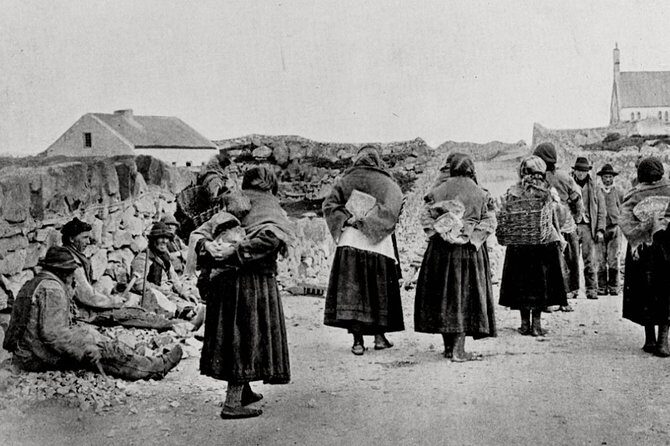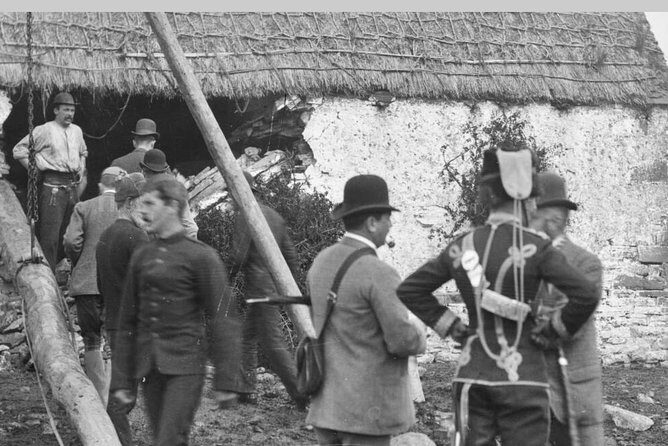Irish Famine Museum / Exhibition Dublin: A Thoughtful Journey into Ireland’s Past
If you’re in Dublin and want to understand a pivotal chapter of Irish history, the Irish Famine Museum offers a compact yet impactful experience. For just $16.28 per person, you get a self-guided tour lasting about an hour, located conveniently within Dublin’s city center at the St. Stephen’s Green Shopping Centre. The exhibition features photographs, artifacts, and a compelling 15-minute documentary that brings to life the stories of the Great Famine, which devastated Ireland in the mid-1800s.
What we love most about this experience is the ability to explore at your own pace, digesting the history on your terms, and the unexpected bonus of aerial views of St. Stephen’s Green park—a rare perspective that makes the visit even more memorable. Plus, the availability of a multilingual translation guide in French, German, Italian, and Spanish helps make the experience accessible for diverse visitors.
A slight consideration is that the exhibit is relatively short and focused on the famine’s story, so if you’re seeking a more extensive or interactive museum experience, you might find this a bit limited. However, for those wanting a focused, authentic glimpse into Ireland’s hardships and political responses, this tour offers genuine value. It’s particularly well-suited for history buffs, students, and travelers eager to understand the causes and consequences of Ireland’s Great Hunger.
Key Points
- Self-guided exploration allows you to take your time and absorb the stories at your own pace.
- The aerial view of St. Stephen’s Green provides a unique perspective, connecting history with the present cityscape.
- The short documentary is a compelling way to introduce the famine’s impact quickly.
- The exhibit is affordable and can be booked 25 days in advance, ensuring easy planning.
- The availability of multilingual guides makes the experience accessible for international visitors.
- Reviews praise the exhibit as a powerful, straightforward account that aids understanding Ireland’s past.
The Experience in Detail
Location & Accessibility
Starting inside the St. Stephen’s Green Shopping Centre, the Irish Famine Museum is easy to find and near public transportation options. Its central location means you avoid long commutes after a day of sightseeing. The self-guided nature means you can visit anytime during the opening hours, which run from 12 PM to 6 PM daily from April to September. This flexibility is appreciated, especially if you prefer to explore at your own pace rather than being part of a tour group.
What to Expect at the Museum
Once inside, you’ll be greeted with a straightforward, well-curated exhibit that chronicles the Irish Potato Famine, often called the Great Hunger. The focus is on the political decisions, the slow disaster response, and the human stories behind the statistics. Artifacts and photographs help make the famine’s impact tangible, while the 15-minute documentary offers a concise visual and narrative overview.
The aerial views of St. Stephen’s Green park are a highlight. From the museum’s vantage point, you’ll see the park from above, offering a fresh perspective that links the historical context to the modern city. It’s an unexpected bonus that many reviews mention, adding depth to an otherwise straightforward exhibit.
Insights from Visitors
Many travelers have expressed how powerful and affecting the exhibit is. Valarie_O notes it’s a “quick self-guided temporary exhibition that highlighted the poor political decisions and slow disaster response.” AlanM_B echoes this by pointing out the ineptitude of the British government and landowners, which played a role in exacerbating the suffering.
Others, like Simon_R, mention that the exhibit clarified the reasons behind Ireland’s large emigration, stating, “Now I understand what was a reason for emigrations, 5 million Irish people were thrown out from the island.” Such insights show that the exhibit, while brief, packs a punch in explaining Ireland’s demographic shifts.
Practical Details & Value
The admission price of approximately $16.28 is quite reasonable for an educational experience with authentic artifacts and a documentary. The self-guided format allows flexibility—you’re free to spend more or less time at different sections, making it perfect for travelers with tight schedules. The availability of translations in multiple languages broadens its appeal, and booking in advance is recommended, as it’s popular, booked about 25 days beforehand on average.
What’s Not Included
You have the option to purchase a book or USB stick of the exhibition if you want to take the story home or review it later, but it’s not necessary to enjoy the core experience. The exhibit itself is designed to be self-contained and informative.
Museum lover? We've covered these other cultural institutions in Dublin
Who Will Appreciate This Experience?

This tour is ideal for history enthusiasts wanting a focused, authentic account of Ireland’s famine, students studying Irish history, or travelers seeking a meaningful cultural stop without dedicating hours. It’s especially suitable for those who prefer self-guided exploration over guided tours, and for visitors who appreciate well-curated exhibits with artifacts and visual storytelling.
People who value authentic, impactful storytelling that connects past to present will find this tour compelling. If you’re interested in understanding Ireland’s socio-political struggles or want a quick, affordable way to deepen your knowledge, this exhibit hits the mark.
Final Thoughts

The Irish Famine Museum in Dublin offers a concise, powerful look into one of Ireland’s most defining tragedies. Its self-guided format provides flexibility, making it easy to fit into a busy itinerary. The fair price combined with compelling artifacts and a short documentary makes it a valuable educational experience that doesn’t overreach but leaves a lasting impression.
While it may not be the place for those seeking an interactive or large-scale museum experience, it excels in delivering authentic storytelling and historical clarity. The aerial views of St. Stephen’s Green add a special touch, bridging the past and present beautifully.
Overall, if you want to understand Ireland’s hardships and appreciate its resilience, this exhibition is well worth your time. It’s particularly suited for thoughtful travelers who value history with context and authentic, meaningful experiences.
Frequently Asked Questions

Is this a guided tour or self-guided?
It is a self-guided tour, allowing you to explore at your own pace with an included audio-visual component and artifacts.
How long does the exhibition take?
Most visitors spend about one hour exploring the exhibit, watching the documentary, and enjoying the views.
Can I visit at any time?
Yes, the exhibit is open every day from 12 PM to 6 PM during the season from April to September. It’s best to book in advance to secure your spot.
Is the exhibit suitable for children?
Children are welcome but must be accompanied by an adult. The exhibit’s focus on historical suffering can be quite impactful, so parental discretion is advised.
Are there translation guides available?
Yes, guides are available in French, German, Italian, and Spanish to help non-English speakers understand the stories better.
Can I purchase souvenirs or additional materials?
You can buy a book or USB stick of the exhibition if you wish, but these are optional extras.
Is the location accessible?
The museum is located within the shopping centre, which is accessible and near public transportation.
What should I bring?
Bring comfortable shoes for walking and perhaps a notebook if you want to jot down insights. The exhibit doesn’t require special gear.
How does the aerial view enhance the experience?
It offers a bird’s-eye perspective of St. Stephen’s Green park, connecting the historical stories to the city’s current landscape, enriching your understanding.
To sum it up, the Irish Famine Museum provides a thoughtful, accessible, and well-priced way to deepen your appreciation of Ireland’s past. It’s an experience that stays with you long after leaving Dublin’s bustling streets, especially for those eager to understand the resilience behind Ireland’s modern identity.
More Museum Experiences in Dublin
- Dublin IRA History Tour with Skip-the-line GPO Museum Ticket
- The National Gallery of Ireland Dublin Private Tour, Tickets
- Private Tour of Dublin Museums (Walking Tour)
- Skip the Line: The National Wax Museum Admission Ticket
- Giant’s Causeway with the Titanic Exhibition and the best of Northern Ireland
- Irish Whiskey Museum: Whiskey Blending Experience
- Blarney, Rock of Cashel & Cahir Castles Day Tour From Dublin
- Cliffs of Moher, Doolin, Burren and Galway Day Tour from Dublin
- The Little Museum of Dublin All-Day Flexi Ticket
- Dublin: Glendalough, Wicklow, Kilkenny and Sheepdog demonstration
- Dublin Jameson Distillery and Guinness Storehouse Guided Tour
- Big Bus Dublin Hop-on, Hop-off Sightseeing Tour with Live Guide
More Tour Reviews in Dublin
- Wicklow Mountains and Kilkenny City Private Tour with Chauffeur
- Dublin in a Day Private Tour: Book of Kells & Guinness Storehouse
- Do Dublin, Like a Dubliner a Half Day Walking Tour
- Dublin Airport to Slieve Donard Resort & Spa Private Car Service
- Dublin Airport to Galway Private Premium Car Service
- Best Intro Tour of Dublin with a Local
More Dublin experiences we've covered
- We Rank The 10 Best Boat Tours & Cruises In Dublin
- Which Dublin Workshops & Classes To Choose? Our Best 4 Picks
- What Are The Best Walking Tours In Dublin? Our Top 16 Picks
- 16 Most Highly Rated Tours In Dublin
- The 7 Top Shore Excursions In Dublin: Which Is Best?
- What Are The Best Private Driver Services In Dublin? Our Top 16 Picks
- We Rank Dublin’s 3 Top Photography Experiences
- You’ll Love These 16 Historical Tours In Dublin
- Which Dublin Hiking And Trekking Tours To Choose? Our Best 8 Picks
- You’ll Love These 14 Full-Day Tours In Dublin
- 15 Best Food Tours In Dublin (With Reviews & Prices)
- We Rank Dublin’s 16 Top Drinking Tours
